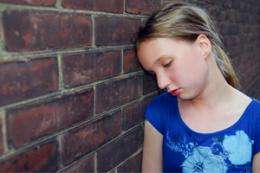Girls report more mental distress and are prescribed more psychiatric drugs than boys

More than 15 percent of Norwegian teenagers ages 15 to 16 reported “mental distress,” or symptoms of depression and anxiety, with significantly more girls reporting distress than boys, according to a new study in the Journal of Adolescent Health. Girls with mental distress were also more likely than their male counterparts to be prescribed psychotropic drugs—those that alter chemical levels in the brain, affecting behavior and mood.
One in five girls reported mental distress, a rate three times higher than reported by boys. Girls also had the highest prescription rates for subsequent psychotropic drugs. More than a quarter of mentally distressed girls ages 15 to 16 registered as a new psychotropic drug user before they reached the age of 25.
The study analyzed data from almost 12,000 adolescents participating in the Norwegian Health Surveys of 2000 – 2003. Study participants self-reported mental distress, health and lifestyle habits, future education plans and family economics. Researchers linked data from all of the participants to the Norwegian Prescription Database (NorPD) of 2004 – 2009. Norwegian pharmacies must legally report electronic prescription data for all individuals living outside institutions.
The availability of information about adolescents and prescription drug use is limited, said the authors. “The database offers a unique possibility to share information on these study issues and other future studies,” said lead study author Anne Kjersti Myhrene Steffenak, M.C.C., of Hedmark University College in Elverum, Norway.
“Norway has a wonderful advantage in that they have nationwide health registries, which can help to give them a good idea of what is occurring in health care delivery and outcomes,” said Leslie R. Walker, M.D., president of the Society of Adolescent Health and Medicine and Chief of the Division of Adolescent Medicine at University of Washington Seattle Children's Hospital.
Norwegian teens with mental distress also reported poorer health, with 94 percent of the girls reporting pain in at least one location on their bodies, a higher consumption of alcohol and daily smoking, less physical activity, plans for vocational careers and lower family income.
Steffenak found the notable gender differences in the initiation of drug treatment most intriguing and asked, “Are they due to the way we behave as parents, as a society, or are these biological differences? After accounting for gender differences in mental distress, girls are still more likely to initiate psychotropic drug use than boys.”
Dr. Walker noted that girls receive more medications in general than boys. “This could be due to female reproductive concerns yielding more medical visits and more opportunities to disclose other medical concerns that were not the primary complaint,” Walker postulated.
The United States prescribes more psychotropic drugs in adolescence than any other country, she said. “Does this mean we are missing opportunities to identify these youth at risk and intervene before there is a need for prescription treatment? It remains to be studied.”
More information: Steffenak, A., et al. (2011). Mental Distress and Subsequent Use of Psychotropic Drugs, Among Adolescents—A Prospective Register Linkage Study, Journal of Adolescent Health. doi: 10.1016/j.jadohealth.2011.10.011













